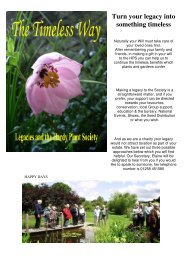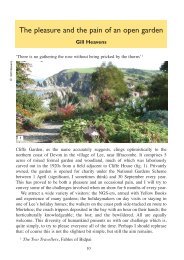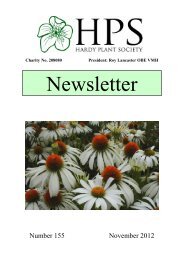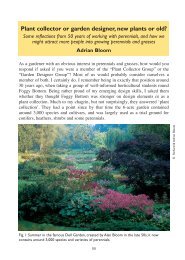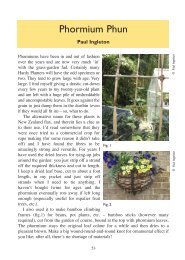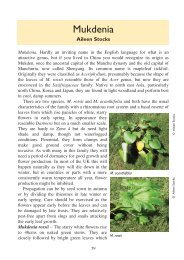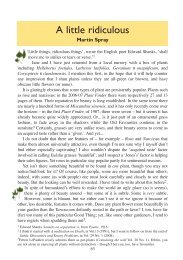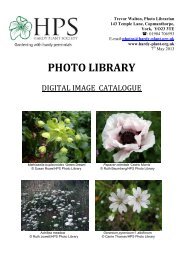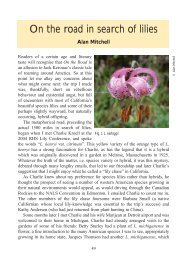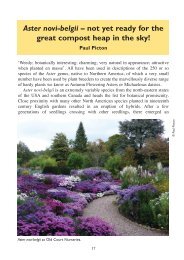Newsletter Skeleton Autumn 2009 - Hardy Plant Society
Newsletter Skeleton Autumn 2009 - Hardy Plant Society
Newsletter Skeleton Autumn 2009 - Hardy Plant Society
You also want an ePaper? Increase the reach of your titles
YUMPU automatically turns print PDFs into web optimized ePapers that Google loves.
<strong>Hardy</strong> Geranium Group<br />
Honorary President: David Victor<br />
Geranium brycei<br />
<strong>Newsletter</strong> – <strong>Autumn</strong> <strong>2009</strong>
Officers of the <strong>Hardy</strong> Geranium Group<br />
Chairman:<br />
Margaret Stone<br />
‘Brockamin’, Old Hills, Callow End, Worcs. WR2 4TQ<br />
Tel. 01905 830370 e-mail: dickstonebrockamin@tinyworld.co.uk<br />
Secretary & Treasurer:<br />
Oliver Folkard<br />
1, Baron’s Close, Fakenham, Norfolk NR21 8BE<br />
Tel. 01328 851468 No e-mail<br />
Seed Exchange Managers:<br />
Andrew & Dodo Norton<br />
Oaklands Farmhouse, Hinton Park, Somerset TA17 8TH<br />
Tel. 01460 52674 e-mail: andrew.norton@virgin.net<br />
<strong>Newsletter</strong> Editor:<br />
Paul P Davis<br />
‘Oakdene’, Green Lane, Abermule, Montgomery, Powys SY15 6LB<br />
Tel. 01686 630734 e-mail: paul.paget3@btinternet.com<br />
Committee Members:<br />
Tricia Fraser, 16 Hallam Grange Croft, Sheffield, South Yorkshire<br />
S10 4BP<br />
Robin Moss, ‘Braeside’, Woodside Villas, Hexham, Northumberland<br />
NE46 1HX<br />
Tricia Newton, 18 Templand Park, Allithwaite, Grange over Sands,<br />
LA11 7QS<br />
The opinions expressed by the authors are their personal views and not<br />
specifically endorsed by the HPS <strong>Hardy</strong> Geranium Group. The Editor<br />
reserves the right to edit contributions as necessary.<br />
2
From the Chair<br />
Margaret E Stone<br />
Many consider autumn to be the beginning of the gardening year;<br />
changes are made and plants propagated for the following summer.<br />
If you are making your New Gardening Year resolutions, let one of<br />
them be to attend Geranium Day.<br />
It was a small group that met this year but all were enthusiastic and<br />
friendly and the sun shone on us. I should like to repeat my thanks<br />
to Jenny and Mike Spiller for organising the hall and refreshments<br />
and to Andrew Norton for entertaining us. All the members who<br />
attended helped to make the day a success but special mention is<br />
due to Geert Lambrecht, who came from Belgium to show us some<br />
interesting flowers. If you were not there, you will be pleased to<br />
know that we elected Joy Jones our first Honorary Life President<br />
and David Victor our new President. There was overwhelming<br />
support for raising the subscription and members suggested the new<br />
rate of £5, which should be sufficient to remain unchanged for a long<br />
time. This means that you can take out a standing order and will not<br />
have to amend it too soon.<br />
If you have a particularly interesting geranium, do pot it up and bring<br />
it to show us next year. We should also like to hold a “trial” of x<br />
oxonianum cultivars – potted plants of as many as possible. Bring<br />
yours and we shall display them all. This could reveal any naming<br />
problems (Are some being sold with incorrect names?) and may<br />
resolve some (bring your “unknowns” for comparison). Now is the<br />
time to pot them up. Are there any geraniums that you would<br />
particularly like to buy? Send in your “Wants” and other members<br />
may be able to propagate them. (See page 8 for details.)<br />
In the last newsletter I appealed for plants for the HPS Chelsea<br />
stand. Not many members replied and some of those who were<br />
willing lived too far away. However, we did grow a respectable<br />
amount, thanks mainly to Paul Davis, who produced first class<br />
exhibits. The plants were duly transported to Chelsea and, if you<br />
attended the show or looked at the photos on the website, you will<br />
have seen that hardy geraniums were a major feature. With<br />
excellent staging and attention to detail, they looked magnificent and<br />
3
won a Gold Medal. Thanks are due to those who contributed in<br />
some way to make this possible; it is a major “milestone” in the<br />
history of the HPS.<br />
Our former Secretary, Tricia Fraser, has been the HPS webmaster<br />
for some time but resigned in July. We are grateful for all the work<br />
she did on the website but I am hoping that she will now be free to<br />
continue on the HGG committee! I have asked for an HGG area on<br />
the new website and the committee are currently considering what<br />
should go on it. I should like to include “Where to see and buy hardy<br />
geraniums in member’s gardens and nurseries”. If you could be<br />
included in the list (e.g. if you grow many geraniums and open for<br />
the NGS) please let me know. A list of plants introduced by<br />
members would also be interesting so please send me details of any<br />
plants you have named or of species introduced from the wild.<br />
Please do not e-mail photos to me because I do not have<br />
broadband! Paul Davis would be happy to have them. Do you have<br />
any other ideas for our website content? Send them in!<br />
Hoping for a good response.<br />
Minutes of HPS <strong>Hardy</strong> Geranium Group Annual General Meeting<br />
20 th June <strong>2009</strong><br />
Present<br />
Margaret Stone<br />
Andrew Norton<br />
Paul Davis<br />
Chair<br />
Seed Exchange Manager<br />
<strong>Newsletter</strong> Editor<br />
and 17 members<br />
Apologies for Absence<br />
Oliver Folkard, Tricia Fraser, Robin Moss, Anne Hooper, Fran<br />
Pattinson and Pam and Bob Shaw.<br />
4
2008 AGM<br />
As there was no AGM in 2008, there were no minutes. The postal<br />
ballot held had approved the minutes of the 2007 AGM, the<br />
accounts for 2007 and the new committee.<br />
Accounts for 2008<br />
The Group made a net deficit of £346.93 on the year. This was<br />
mainly caused by increased <strong>Newsletter</strong> production costs, an extra<br />
committee meeting and reduced income because there was no<br />
Geranium Day. Since, <strong>Newsletter</strong> costs have been substantially<br />
reduced by the Editor printing the <strong>Newsletter</strong> on a home printer.<br />
The accounts were approved: Proposer, David Victor; seconder,<br />
Paul Davis.<br />
Membership Report<br />
Membership numbers have fallen slightly to 154 (190 including joint<br />
members). A possible reason for the fall in overseas members is the<br />
increased control over seed imports being exercised by some<br />
countries. It was proposed that an information leaflet about the<br />
Group be produced to attract new members; this was approved by<br />
members, who thought that ‘beginners’ should be encouraged to<br />
join.<br />
Election of Officers and Committee Members<br />
The existing committee members were willing to stand for election<br />
and a new volunteer was welcomed. The <strong>2009</strong>/10 committee is<br />
therefore:<br />
Chair<br />
Secretary & Treasurer<br />
Seed Exchange Manager<br />
<strong>Newsletter</strong> Editor<br />
Committee Members<br />
Margaret Stone<br />
Oliver Folkard<br />
Andrew Norton<br />
Paul Davis<br />
Tricia Fraser<br />
Robin Moss<br />
Tricia Newton<br />
5
Elected unanimously: Proposer, Mike Spiller; Seconder, Jenny<br />
Spiller.<br />
Election of Honorary President for <strong>2009</strong>/10<br />
Joy Jones, our long-standing Honorary President, has asked to<br />
stand down because of her advancing years. It was therefore<br />
proposed by Margaret Stone and seconded by Andrew Norton that<br />
David Victor be elected to this position. Carried unanimously.<br />
Amendment to the Constitution of the Group<br />
It was decided at the February meeting of the HGG Committee that<br />
an amendment to our constitution be put to the AGM, such as to<br />
allow the Group to elect Honorary Life Presidents. The Trustees of<br />
the HPS gave their consent to this proposal on 25 th April <strong>2009</strong>. On<br />
being put to the meeting, the amendment was carried unanimously.<br />
Proposer, Margaret Stone; Seconder, Andrew Norton.<br />
Election of Honorary Life President<br />
Joy Jones having stood down as Honorary President was nominated<br />
for election as an Honorary Life President in recognition of her hard<br />
work in sustaining the Group with direction and leadership over<br />
many years. Proposer, Andrew Norton; Seconder, Margaret Stone,<br />
and elected unanimously.<br />
Membership Subscriptions<br />
The general cost of administering the Group has risen over the<br />
years, particularly the cost of printing and posting the <strong>Newsletter</strong>, so<br />
the committee recommended an increase in subscription from £3 to<br />
£4. After discussion it was agreed that subscriptions should be<br />
increased to £5 for UK members while remaining at £5 for overseas<br />
members. Proposer, Paul Davis; Seconder, David Victor, and<br />
carried unanimously.<br />
6
Other Business<br />
The committee was asked if it would be possible to have Geranium<br />
Days with more ‘Hands on’ tuition, or members bringing plants for<br />
discussion.<br />
2010 Subscriptions Oliver Folkard<br />
Subscriptions are due on 1 st January 2010 – as you will have seen<br />
from the report of the AGM, the subscription is now £5 for all<br />
members, UK and Overseas alike.<br />
Payment by cheque<br />
Please return the payment slip enclosed with this <strong>Newsletter</strong> with<br />
your cheque. If your address or other details are incorrect, please<br />
return the amended form to me.<br />
Payment by Standing Order<br />
Members who pay by standing Order should notify their bank of the<br />
change in the amount to be paid to the Group. Again, if your address<br />
details are incorrect please return the amended form to me –<br />
otherwise there is no need to return the form.<br />
Setting up a Standing Order<br />
Payment by Standing Order is convenient both for you and for me!<br />
Standing Orders are under your control (unlike Direct Debits) and<br />
can be cancelled through your bank if you decide to resign from the<br />
Group. The Group’s bank account details for setting up a Standing<br />
Order are on the membership renewal form.<br />
Overseas Members<br />
Overseas members should continue to pay their subscriptions to<br />
Pam Adams along with their HPS national subscription. Pam then<br />
sends that member’s details and subscription on to me.<br />
7
2010 – A date for your diary – Saturday June 19 th 2010<br />
Next years Geranium Day and AGM will be held on Saturday June<br />
19 th 2010. It will be held in Worcestershire, and will include a visit to<br />
the garden of our Chair, Margaret Stone, which has recently been<br />
granted national Collection status for some Geranium species. It<br />
may also include a ‘Bring your own Oxonianum’ session.<br />
Full details will be announced in the Spring 2010 <strong>Newsletter</strong><br />
Wants<br />
Margaret Stone<br />
If you intend to come to Geranium Day a new addition to our plant<br />
sale may interest you. If you would like to buy a particular geranium<br />
(or a few), send the name(s) to Paul Davis. He will compile a list for<br />
publication in the spring newsletter. Hopefully, members will then pot<br />
up any they can and donate them to the plant stall on Geranium<br />
Day. “Your” plant(s) will be reserved for you to buy.<br />
The Group encourages propagation of species via the seed<br />
exchange but our plant stall enables us to distribute cultivars as well.<br />
This helps to conserve them. It also raises funds for the Group. You<br />
are welcome to donate other geraniums in the usual way.<br />
Seed Exchange <strong>2009</strong><br />
Andrew Norton<br />
The time has arrived to send seed (if any was collected this year) to<br />
the seed exchange Managers (details below). The seed exchange is<br />
a very important aspect of the Group’s activity. It is vital that seed is<br />
exchanged every year to ensure that plants are continually<br />
propagated resulting in their conservation.<br />
Please send even the smallest number of seeds clearly labelled, if<br />
you have any to:<br />
Andrew & Dodo Norton, Oaklands Farmhouse, Hinton Park,<br />
Somerset TA17 8TH<br />
Email contact: andrew.norton@virgin.net<br />
The seed list will be posted or e-mailed to all members<br />
automatically. (Ed)<br />
8
Who am I?<br />
Tricia Newton<br />
I am a keen organic gardener and complete plantaholic, though at<br />
the moment several hundred of my plants are in pots, waiting to<br />
move. I have lived in Cumbria for just under three years and many of<br />
these plants moved with me. I was allowed to gently redesign my<br />
husband’s small garden (which meant keeping the lawn) and now I<br />
badly need a larger plot to play in as I have collected lots more<br />
plants from some wonderful nurseries, both near and far. I even<br />
managed to bring back a few in my suitcase, from a first visit to<br />
Ireland in July. This year I have tried to concentrate on buying<br />
plants for bees and butterflies though, sadly, the very wet summer<br />
has meant there have been very few in the garden.<br />
As well as being a member of <strong>Hardy</strong> <strong>Plant</strong>s I belong to the Lakeland<br />
Horticultural <strong>Society</strong> and each Wednesday sees me working as a<br />
volunteer at their beautiful garden at Holehird, near Windermere.<br />
Before moving north I lived in Hampshire for many years, and have<br />
decided that I much prefer my previously chalky soil to the heavy<br />
clay I have to garden now. Much as my roses like the soil they don’t<br />
like the damp conditions and do not thrive although my geraniums<br />
are coping very well indeed. However, one of the many advantages<br />
of gardening at Holehird, where the soil has a pH of around 6.6, has<br />
been the opportunity to learn more about acid-loving plants.<br />
I first became interested in gardening as a child, watching my Dad<br />
and visiting my Granddad in Kent where he had a huge garden with<br />
a vegetable plot and an orchard and this has left an indelible mark<br />
on me. Since having my own home, gardening has become a real<br />
passion. Ironically, and completely by chance, my first two<br />
purchases were geraniums and I have loved them ever since.<br />
Over the years I have attended several part-time gardening and<br />
garden design courses and study days as well as visiting as many<br />
gardens and nurseries as possible. I have been lucky enough to see<br />
some beautiful gardens but my favourite is still Kiftsgate. My ultimate<br />
dream is to run a small B&B for garden lovers with a small garden<br />
9
nursery attached and I hope to realise that dream within the next two<br />
years. Fingers crossed!<br />
The <strong>Hardy</strong> Geranium Group meeting in June was the first one that I<br />
have attended since recently joining the group and I was amazed<br />
and inspired by the knowledge of the members. I was delighted to<br />
join the committee and hope very much to be able to serve the<br />
group well.<br />
Geraniums in the Eastern Cape<br />
David Victor<br />
In recent years an increasing number of us have visited South<br />
Africa, as there are many attractions in that country and for those of<br />
us interested in plants it is a veritable wonderland. Most of us visit<br />
the Western Cape, working our way out from Cape Town into its<br />
relatively nearby hinterland. This is the area so often high-lighted in<br />
television programmes, which frequently show the miles and miles of<br />
countryside covered by various members of the daisy family.<br />
This area is known as the Mediterranean Climate Region, of the<br />
Cape Floristic Region. It is a winter rainfall region, its plants being<br />
dependant on rains which sweep in from the Atlantic, particularly<br />
during their winter, May to August. It is very rich in plant species,<br />
with many being endemics.<br />
Whilst this area is well known, it is only part of the Cape Floristic<br />
Region. <strong>Plant</strong> lovers often visit other parts of the Region as part of<br />
their Western Cape visit but, sadly, this does not allow them to see<br />
these other areas at their best. The reason for this is that the other<br />
areas (Eastern Cape and KwaZulu Natal) are to the East and<br />
receive their rain from the Indian Ocean and this comes later in the<br />
year: The main rainfall months in Durban are from November to<br />
March. As a result, to see the plants of this area at their best you<br />
need to travel there in January or February, as opposed to<br />
September to October in the Western Cape.<br />
Having been to the Western Cape a number of times before, this<br />
year I chose to go to the Eastern Cape at the end of January. I<br />
joined a small group arranged by the Alpine Garden <strong>Society</strong>, which<br />
10
travelled from Port Elizabeth on the south coast, to the Drakensberg<br />
Mountains on the Lesotho border and back. The tour was led by a<br />
wonderfully knowledgeable guide, Cameron McMaster.<br />
This was a very interesting tour as it encompassed a wide variety of<br />
habitats, from sea level fynbos, through desert areas to mountain<br />
passes. We started at sea level and our highest point was just below<br />
10,000 feet at the top of the Tifendell ski resort. The southern part<br />
of the area covered had been in drought for the previous year, so<br />
flowering was somewhat less than we had hoped. However, in the<br />
north rain had been more plentiful and there was plenty to be seen.<br />
The area holds a number of members of the Geraniaceae family,<br />
mostly drawn from the Pelargonium and Geranium genera and we<br />
saw many of these, mainly in flower.<br />
Amongst the Geranium that we saw were the following:<br />
G. baurianum – This is a species that I had not come across<br />
before and I think is not in cultivation. We found it growing at<br />
a dry woodland edge at 3,200 feet near Stutterheim. Group<br />
unknown;<br />
G. brycei – Reasonably well know in cultivation, rather like a<br />
small G. robustum to my mind. We found it growing in a<br />
sandy location, with short grass on Naude’s Nek, a pass at<br />
just over 8,000 feet. A member of the Robustum Group;<br />
G. caffrum – Another plant seen regularly in cultivation and,<br />
to my mind, not one of the more attractive ones. The ones<br />
that we saw were near to the end of their flowering. We<br />
found them at the Wainek Reserve, near Somerset East, in<br />
long grass on a very open face at 5,000 feet<br />
A member of the Robustum Group, though by no means as<br />
attractive as that species;<br />
G. multisectum – This plant is sometimes seen in cultivation<br />
and would, I think, be another member of the Incanum<br />
Group. This one, however, is a more attractive plant. This<br />
was found close to G. brycei discussed above;<br />
11
G. robustum – The namesake of the Robustum Group and a<br />
well know plant in cultivation, though often through its hybrids<br />
with G. incanum, which form the Rambling Robin Group of<br />
cultivars. In nature it is a rather more handsome plant than the<br />
way I have seen it in my garden, where it tends to make a<br />
heap, rather than an attractive sub-shrub. We saw it on sunny<br />
banks near Naude’s Nek at just over 8,000 feet;<br />
Geranium robustum<br />
G. schlechteri – One of a small group of species in a Group of<br />
which it is the namesake. Sometimes seen in cultivation, I think<br />
that I had the first plants in cultivation in the UK, from Silverhill<br />
seeds. Not one that I grow today. The plants that we saw were<br />
growing at the base of cliff faces on the slopes of a pass<br />
known as Satan’s Nek, at around 7,000 feet.<br />
The species shown above were all seen in a number of locations,<br />
the ones noted being the ones where I happened to take a series of<br />
12
photographs for my records. Most of them are widespread over the<br />
Eastern Cape and eastwards. All of them formed attractive plants in<br />
nature, which they sometimes do not do in cultivation. It’s worth<br />
adding that all of them were growing at altitudes where low winter<br />
and night-time temperatures are experienced and should be able to<br />
be grown outside in most of the United Kingdom, with little<br />
protection.<br />
Geranium multisectum<br />
I should add that it can be very warm early in the calendar year; we<br />
were well into the 80’s and sometimes the 90’s. However, if you get<br />
the opportunity to experience the summer rainfall area, take it and<br />
you will be well rewarded. The place is beautiful and the plants<br />
breath-taking<br />
13
The Alan Bremner Geranium Hybrids<br />
Commercial introductions<br />
- an assessment by Robin Moss<br />
This article is a revision and updating of an article I wrote for the<br />
Geraniaceae Group News in the winter 1996/7 edition. Given the<br />
significant number of new releases of Alan’s plants since then, I felt<br />
it appropriate to add to that original article.<br />
Alan Bremner’s incredible work on hybridising Geraniums has been<br />
perhaps the single most important work in this area since the<br />
publication of Peter Yeo’s book in 1985. It has without doubt added<br />
significantly to our knowledge of Geraniums, and also to the range of<br />
plants available. At the time of publication of Peter Yeo’s book there<br />
were only a handful of known hybrids – some deliberately created,<br />
others random hybrids from the garden or the wild. Yeo records the<br />
scientific work done in this area – usually PhD work within very<br />
limited areas. Perhaps the scientific and botanical implications of<br />
Alan’s work will in the long term have the most impact, and there is<br />
surely scope for an enormous amount of professional follow-on work<br />
both by way of assessing the implications of his work, and taking it<br />
further.<br />
Anyone familiar with the enormous amount of diligence, care and<br />
dedication that Alan has devoted to this work will agree that such<br />
botanical attention to the facts of these hybridisations would make a<br />
fitting testament to his endeavours.<br />
What follows is a listing of the introductions of Alan Bremner’s<br />
hybrids so far, with a record of parentage, attributes, and an attempt<br />
at judgement on plant worthiness – although I stress these<br />
judgements are both personal and based on growth in my own<br />
garden, where conditions are affected to some extent by the sheer<br />
number of Geraniums grown and lack of space. The plants are listed<br />
as far as possible in chronological order of introduction.<br />
14
Note: ‘Nigricans’ here is G. sessiliflorum ssp novaezelandiae<br />
‘Nigricans’<br />
1 ‘Sea Spray’ (G. traversii x ‘Nigricans’)<br />
Introduced in 1991/2 by Cally Gardens. A sprawling thug – prostrate<br />
stems with large (for type) bronze and silver leaves and pinkish<br />
fading white flowers. Good groundcover plants for difficult situations<br />
– up to 1.2m spread. Prolific seeds – every seedling a new plant!<br />
(Now rarely listed).<br />
2 ‘Sea Pink’ (G x oxonianum x ‘Nigricans’)<br />
1991 Charterhouse Nursery. Another ground-hugging plant albeit<br />
not as thuggish as ‘Sea Spray’ – almost delicate in foliage, smaller<br />
shiny khaki green. Flowers pale pink, with slight veining. ‘Kate’ is<br />
very similar. Would ‘Sea Pink’ have been named had ‘Kate’ been<br />
more widely available, one has to ask. Otherwise a good rockery<br />
plant. (Now rarely listed).<br />
3 ‘Sea Fire’ (G x oxonianum x ‘Nigricans’)<br />
1992 Axletree. The same could be said of this plant, which has<br />
similar khaki green/brown foliage, but small red-pink flowers with a<br />
white eye. My favourite of the above three plant, but I have lost all<br />
three in harsh winters. (Now rarely listed).<br />
4 ‘Dilys’ (G .procurrens x G, sanguineum)<br />
1992 Axletree. Dainty sanguineum-like foliage, plant sprawling up to<br />
90cm. Flowers softer purple than G. sanguineum, with dark veins,<br />
from July through to November. Though not a prolific flowerer in my<br />
garden, useful on a rockery or front of border for late season colour.<br />
5 ‘Chantilly’ (G. renardii x G, gracile)<br />
1992 Axletree. Pale green foliage, rounded lobes, paler than<br />
‘Philippe Vapelle’., 45 cm tall. Very pale lavender pink flowers with<br />
light veining. In a large clump this is a pleasing plant, but I have<br />
difficulty establishing it thus. I have therefore become less<br />
enamoured with this plant.<br />
6 ‘Philippe Vapelle’ (G. renardii x G. platypetalum)<br />
1992 Axletree. Identical to the plant introduced by Ivan Louette in<br />
15
Belgium. The Alan Bremner plant is sold in this country under this<br />
name. Masses of slate blue-purple flowers, separated petals, over<br />
the wonderful G. renardii type foliage.<br />
7 ‘Joy’ (G. traversii x G. lambertii)<br />
1992 Axletree. Flowers a soft lilac pink; best on a rockery. Ideal for<br />
those who admire the subtle charm of G. lambertii, but be warned,<br />
hard winters kill this and the similar ‘Coombeland White’.<br />
8 ‘Patricia’ (G. endressii x G. psilostemon)<br />
1993 Axletree. One of the best of Alan’s hybrids. Easy to grow, easy<br />
to propagate, combining all the boldness of G. psilostemon, without<br />
the violent magenta aggression. The flower is a reddish pink with the<br />
large dark eye of the dominant parent. Begins flowering in June and<br />
continues until September. It’s large-lobed, tall foliage (up to 75cm)<br />
makes it ideal for the middle to rear of any border.<br />
9 ‘Anne Thomson’ (G. procurrens x G .psilostemon)<br />
1993 Axletree. Supposedly more compact than the identical clone<br />
‘Ann Folkard’. Perhaps so, but I prefer the ability of the latter to<br />
sprawl and climb through other plants. Otherwise it shares all other<br />
characteristics with ‘Ann Folkard’.<br />
10 ‘Black Ice’ (G. traversii x ‘Nigricans’)<br />
1993 Axletree. A pleasing combination of dark brown foliage and<br />
white flowers. Not quite so thuggish as ‘Sea Spray’, and very difficult<br />
to keep in colder climes. Very good rockery plant. (Now rarely<br />
listed).<br />
11 ‘Little Gem’ (G x oxonianum x G. traversii)<br />
1993 Axletree. One example when an earlier hybrid, ‘Russell<br />
Prichard’, has been significantly improved upon. Appropriately<br />
named, this plant deserves to supplant the earlier hybrid. The<br />
flowers are slightly smaller, but a much more intense lustrous<br />
magenta. Regrettably, the G. traversii parentage means that it has to<br />
have a very well-drained environment to survive Hexham’s wet cold<br />
winters.<br />
16
12 ‘St. Ola’ (G. dalmaticum ‘Album’ x G. macrorrhizum ‘Album’)<br />
1993 Axletree. Flowers larger, more creamy white, than the white<br />
slightly stained pink of ‘Biokovo’. ‘St. Ola’, contrary to what I<br />
originally said, is the better of the two plants, by a country mile.<br />
Great carpeter in shade and dry conditions.<br />
13 ‘Pagoda’ (G. sinense x G. yunnanense)<br />
1993 Axletree. Almost a brilliant plant – the combination of the<br />
velvety maroon/wine purple flowers and mottled foliage. Best when<br />
the petals open and flowers remain rounded, bowl-shaped. With age<br />
the petals separate – the resulting starry shape dissipates the effect<br />
of the wonderful colour. Good in slightly shaded moist conditions<br />
such as G. sinense prefers. Difficult to keep from original cuttings<br />
but seedlings which come true seem to have a greater survivability.<br />
It is a pity that clones with bigger flowers, with petals that do not<br />
separate, were not originally available. This plant is regrettably so<br />
very difficult to keep, and is rarely offered.<br />
14 ‘Orkney Pink’ ((G. traversii x ‘Nigricans’) x G. x oxonianum)<br />
1994 Cally Gardens. My favourite plant from this parentage. Bronze<br />
green leaves combined with masses of strong purplish pink flowers<br />
produced continuously from June to October. A superb rockery plant<br />
that sprawls from a 15cm mound without being too much of a<br />
nuisance, it also seems fairly hardy.<br />
15 ‘Distant Hills’ (G. pratense x g. collinum)<br />
1994 Charterhouse. Judith Bradshaw of Catforth Gardens released<br />
a very similar clone under the name of ‘Harmony’ later the same<br />
year (1994). Another good plant, one of several from this cross. This<br />
hybrid is very garden-worthy, forming strong 90cm tall clumps of G.<br />
pratense like foliage which sets off the myriads of rounded lilac<br />
flowers that have thin reddish veining. Flowers from June to August.<br />
16 ‘Eva’ (G. pratense x G. psilostemon)<br />
1994 Catforth Gardens.<br />
A dusky beauty of a plant, another personal favourite, that is slow to<br />
increase unfortunately, but well worth the effort. Flowers purplishmagenta<br />
with a dark eye. Seen a clump 75cm tall the effect is a<br />
magnificent dusky purplish haze.<br />
17
17 ‘Nicola’ (G. x oxonianum x g. psilostemon)<br />
1994 Catforth Gardens. Named by Judith Bradshaw. Like ‘Patricia’ it<br />
is easy to grow and propagate and is noteworthy because of the<br />
splendid starry effect of its flowers – widely separated magenta pink<br />
petals black veined with a very black eye. A tall vigorous plant,<br />
excellent for the back of the border.<br />
18 ‘Sonata’ (‘Nigricans’ x G. versicolor)<br />
1994 Catforth Gardens. Low-growing rockery plant with small<br />
bronze-green foliage and small starry white flowers. Not really<br />
garden-worthy and not in my opinion either worth naming or<br />
growing, and rarely available, fortunately.<br />
19 ‘Libretto’ (‘Nigricans’ x G. lambertii ‘Swansdown’)<br />
1994 Catforth Gardens. Bronzy green foliage in small tight clumps to<br />
15cm, small trumpet shaped white flowers which grow close to the<br />
foliage. An unassuming shy plant, which I again have doubts about.<br />
Not often sold presently.<br />
20 ‘Prelude’ (G. albiflorum x G. sylvaticum)<br />
1994 Catforth Gardens. Foliage and height typical of the parents,<br />
with many starry lilac-bluish flowers. Early flowering, very nice as<br />
large clumps in semi-shade.<br />
21 ‘Aria’ (‘Nigricans’ x G. rubiflorum)<br />
1994 Catforth Gardens. Difficult to describe because I’ve found it<br />
difficult to grow. Very low clump of bronzy brown foliage, pink<br />
flowers. I wish I could sound more enthusiastic. Seldom if ever<br />
offered for sale.<br />
22 ‘Prime Donna’ (G. pratense x G. clarkei)<br />
1994 Catforth Gardens. Beautiful soft blue full rounded flowers –<br />
foliage intermediate between the parents, plant to 75cm. For those,<br />
like me, who are suckers for blue flowers this is a lovely plant. Easy<br />
to grow – good for front to mid border, avoiding the need for support<br />
inherent in its G. pratense parentage. I have tried to reintroduce this<br />
plant to nurseries as it seems to disappear.<br />
18
23 ‘Silver Pink’ (G. traversii x G. argenteum)<br />
1994 Axletree. For those interested in silver foliage this plant has it –<br />
but little else. 30cm high, silver-grey clump forming plant. However<br />
there are few flowers and those which do appear are identical to G.<br />
traversii. It does not survive our winters in Northumberland. I suspect<br />
there are a few surviving plants elsewhere.<br />
24 ‘Sirak’ (G. gracile x G. ibericum) / ‘Karis’<br />
1995 Axletree. Alan produced two clones of this cross. The larger<br />
clone is identical to the continental introduction of the same hybrid. I<br />
have previously described this magnificent plant as one of the best<br />
introductions of recent years. Longer flowering than G. platypetalum,<br />
of medium height to 75 cm, its purplish flowers are distinctively<br />
veined and it is easy to grow and propagate. The Bremner clone has<br />
subsequently been named ‘Karis’. They are probably hopelessly<br />
mixed up in the trade.<br />
25 ‘Diva’ (G. swatense x G. sanguineum)<br />
1995 Catforth Gardens. Early yellow-green foliage betrays the<br />
hybridity of this plant. In stature and appearance it resembles G.<br />
sanguineum. Flowers are purplish without veining. It would be more<br />
effective if it carried more flowers and retained the yellow-green<br />
foliage. A rockery plant for mid to late summer.<br />
26 ‘Norah Bremner’ (G. rubifolium x G. wallichianum ‘Buxton’s<br />
Variety’)<br />
1995 Axletree. It has a large scrambling spreading habit, with soft<br />
violet-blue flowers centred white. It flowers in late summer. The<br />
petals tend to be separate. It is difficult to propagate, but it is a lovely<br />
plant and worth persevering with. Difficult to find.<br />
27 ‘Elizabeth Ross’ ((G .sessiliflorum ssp novaezelandiae x G.<br />
traversii) x G. x oxonianum)<br />
1995 Charterhouse. Low growing mounds of bright green foliage to<br />
20cm, non-sprawling, with small bright red flowers. Named after the<br />
wife of John Ross. This plant is an interesting contrast of foliage and<br />
flower. For the rockery. Perhaps the most red of any Geranium<br />
flowers – it is a pity that they are not larger and more in number.<br />
19
28 ‘Little David’ (G. psilostemon x G. sanguineum ‘Minutum’)<br />
1996 Axletree. I remember seeing this plant trialled at Axletree and<br />
instantly liking it, largely because of the shockingly rich flower colour:<br />
deep reddish purple flowers with a lustrous sheen on plants only<br />
15cm tall. A rockery plant – a real wonder given its parentage.<br />
29 ‘Scheherazade’ (G. pratense ssp stewartianum x G. clarkei<br />
‘Kashmir White’)<br />
1996 Catforth Gardens. An excellent plant reflecting the good<br />
parentage. Covered in flowers from June to early August. The<br />
flowers are large, cup- shaped and a rich lilac pink. The foliage is not<br />
as finely divided as G. clarkei, and overall the plant is about 60cm<br />
tall. Easy to grow and propagate, excellent for the front or midborder.<br />
However, it has proved difficult to keep. I do not know<br />
anybody who still has it – strangely. If anyone does have it, please<br />
contact me.<br />
30 ‘Natalie’ (G. aff. pratense ex ‘Pamirs’ x G. clarkei ‘Kashmir<br />
White’)<br />
1996 Catforth Gardens. Powder blue bowl-shaped flowers, on a<br />
plant 40cm high. More floriferous, stronger plant, better shaped<br />
flowers than the species parent from the Pamirs. Good for rockery or<br />
front of border. Originally sold un-named in 1996, now named after<br />
one of Judith Bradshaw’s daughters. There are not many smaller<br />
low growing blue Geraniums – this plant fits the gap well. An<br />
excellent plant – it deserves a major commercial introduction.<br />
31 ‘Rebecca’ (G. traversii x G. subcaulescens)<br />
This plant, though named, was never released by Axletree. It no<br />
longer exists.<br />
32 ‘Kirsty’ (G. clarkei ‘Kashmir White’ x G. regelii)<br />
Catforth Gardens. A lovely plant, with cupped flowers, almost white<br />
with distinct veining in Blue/purple, 40-50cm tall. Spreads like a<br />
typical G. clarkei. I have attempted to introduce this plant to<br />
nurseries, where for some reason it seems to have disappeared.<br />
Deserves to be widely distributed.<br />
20
33 ‘Orkney Dawn’ (G. peloponnesiacum x G. renardii)<br />
Crûg Farm <strong>Plant</strong>s. A personal favourite. Same cross as ‘Stephanie’,<br />
but the flowers are a darker violet/blue and more heavily veined.<br />
Foliage more yellow in early season. 40cm tall.<br />
34 ‘Orkney Blue’ (G. ibericum x G. gymnocaulon)<br />
Crûg Farm <strong>Plant</strong>s. Very dark blue/purple flowers – heavily veined,<br />
but not as large as G. x magnificum. 40cm tall.<br />
35‘Welsh Guinness’ (G. sessiliflorum x G. suzukii)<br />
1997 Crûg Farm <strong>Plant</strong>s. A low growing plant with creeping brown<br />
leafed stems and white flowers. Charming plant for rockery or<br />
troughs. Still available, but not very easy to find.<br />
36 G. x cantabrigiense ‘Westray’<br />
Introduced commercially in 2002/3. Typical x cantabrigiense, but<br />
flowers more reddish pink than the normal form of the hybrid, and<br />
more densely floriferous. Good if you like x cantabrigiense.<br />
37 ‘Orkney Cherry’ (x antipodeum x x oxonianum)<br />
2006 M. van Noort. Excellent clump growing rockery plant to 25cm.<br />
Brown foliage with cherry red flowers with a white eye.<br />
38 ‘Solitaire’ (G. libani x G. peloponnesiacum)<br />
2002. This plant was given to a number of people by Alan, but<br />
escaped into the nursery trade – without a name. This was rectified<br />
when it was entered into the Wisley Trials. Hopefully it will now be<br />
circulated under the name. Good rounded lilac/blue flowers –<br />
lavender veins, intermediate in type between the parents. Lovely<br />
augury of spring when it is amongst the earliest flowering<br />
Geraniums. Summer dormant as are both its parents. 30cm tall.<br />
39 ‘Scarpa Flow’ (G. ibericum x G. renardii)<br />
2003/4. Similar story to the above – released by Cally Gardens<br />
without a name. Named when entered for the Wisley Trials. I am<br />
going to release plants with this name in the coming year. I love this<br />
plant. Foliage like G. renardii, but the flowers are very rounded, soft<br />
blue in colour with heavy veining. 30-40cm tall.<br />
21
40 ‘Spindrift’ (x antipodeum x swatense)<br />
Named, but not to my knowledge released.<br />
41 ‘Sabani Blue’ (G. ibericum x G. renardii)<br />
2006 commercial introduction. Very similar in flower to x magnificum,<br />
but flowering much, much earlier in May, reflecting its G. libani<br />
parentage. Useful colour to have in the garden this early in the<br />
season. 40-50cm tall.<br />
42 ‘Perfect Storm’ (G. traversii x G. lambertii x G. procurrens)<br />
2006 Fairweather’s Nursery. Low growing prostrate plant – best on<br />
rockery or well drained soil. This has reddish dusky magenta<br />
flowers, heavily veined with a dark central eye, reflecting its G.<br />
procurrens parentage. The G. traversii element in its breeding may<br />
mean it is not perfectly hardy – it is not with me.<br />
43 ‘Storm Chaser’ (G. traversii x G. lambertii x G. procurrens)<br />
2006 Fairweather’s Nursery. Another clone of the above cross. The<br />
flowers on this plant are lighter in colour – lilac/pink with a dark<br />
veined eye. Another striking plant, possibly even less hardy than<br />
‘perfect Storm’ – or at least in my colder, wetter Northern garden that<br />
is so.<br />
44 ‘Dragonheart’ (‘Anne Thompson’ seed selection)<br />
2006 Fairweather’s Nursery. A monster of a plant – huge dark<br />
magenta purplish flowers up to 5cm in width with a very large black<br />
eye. good for back of border or scrambling through shrubs.<br />
45 ‘Mrs Judith Bradshaw’ (G. gracile x G. renardii ‘Whiteknights’)<br />
<strong>2009</strong> Beeches Nursery. Named at my suggestion after the former<br />
national collection holder who released a number of Alan’s plants.<br />
Never previously released for some reason, it is a wonderful plant<br />
with lovely yellow/green sage like crinkled foliage. The pink flowers<br />
are eyelash veined to ¾ petal length. An excellent garden plant.<br />
60cm tall.<br />
22
46 ‘Alan’s Blue’ (G. clarkei ‘Kashmir White’ x G. saxatile x G.<br />
pratense ssp stewartianum)<br />
<strong>2009</strong> Beeches Nursery. Named by me, with Alan’s agreement,<br />
another of his crosses never previously released. A rambling<br />
vigorous plant to 90cms, with unusual cockade shaped flowers, of a<br />
light blue/lilac colour with white centres and veins to ¾ length.<br />
47 ‘Orkney Mist’ (G. pratense x G. collinum)<br />
2010. Name given by me with Alan’s agreement to an unreleased<br />
clone of the above cross. Vigorous to 90cm. Very floriferous with<br />
clouds of very pale unveined lilac flowers. The other two named<br />
forms of this cross, ‘Harmony’ and ‘Distant Hills’ are veined and<br />
darker. Very good grown in conjunction with G. psilostemon or its<br />
hybrids, or the likes of ‘Orion’ or ‘Brookside’.<br />
Alan, after some respite from breeding, is considering a renewal of<br />
his breeding programme. Many plants from his previous work were<br />
never released – though some deserved such a treatment. For the<br />
most part Alan never benefitted from his efforts. He is a serious,<br />
patient and very systematic hybridiser whose work in my opinion will<br />
never be supplanted or excelled. Both the scientific and plant worlds<br />
owe him a great debt of gratitude.<br />
Geranium Register<br />
David Victor<br />
The new Register runs to 90 foolscap pages and contains all of the<br />
properly Registered Cultivar Names (around 700), names that are<br />
known by the Registrar but not formally Registered (ca. 150) and<br />
those found by the Registrar to be invalid names (ca. 250). Since the<br />
previous version of the Registers, a great deal of more descriptive<br />
information has been added, as well as more information regarding<br />
subjects such as plants subject to <strong>Plant</strong> Breeders Rights in Europe<br />
and elsewhere. The Register is dated September 2008.<br />
The Register is published by the Geraniaceae Group and can be<br />
obtained from:-<br />
Richard Clifton. 5 Tower Street, Dover, Kent CT17 0AJ<br />
The cost to HGG members in the UK is £9.00 including p&p. Please<br />
enclose a cheque when ordering. The document is also available to<br />
overseas members, who should contact Richard by post for details<br />
of cost.<br />
23
Geranium baurianum<br />
Geranium Day at Elworthy<br />
24



